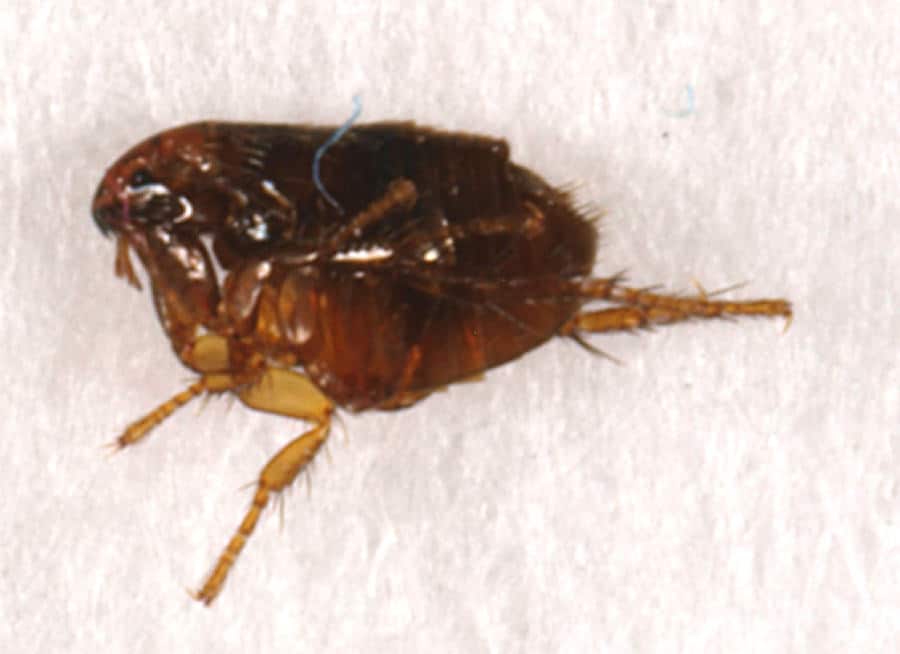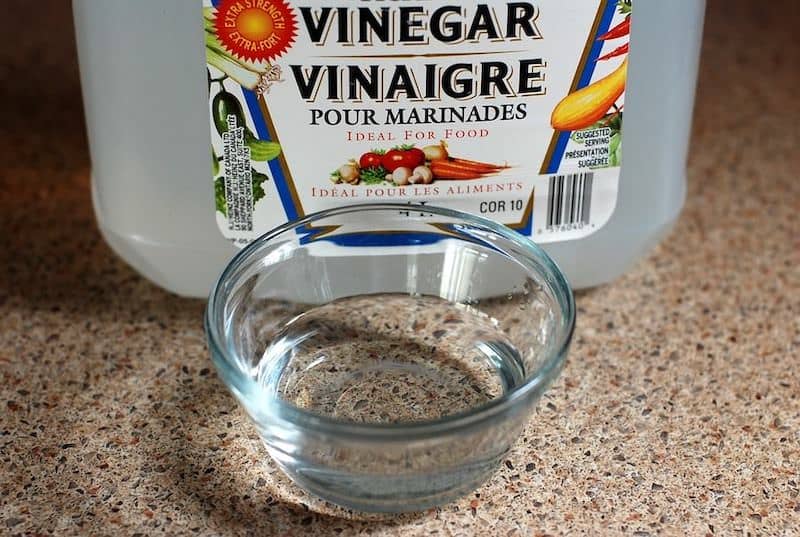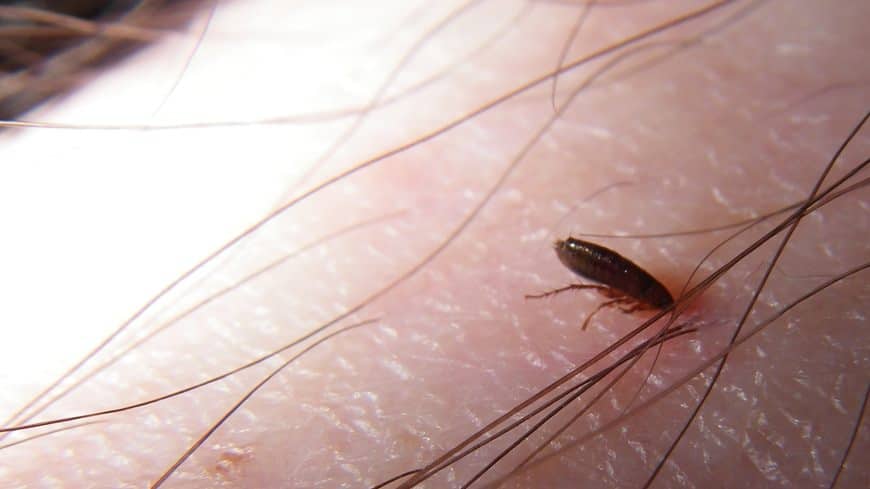How to Get Rid of Fleas on Cats
If your cat has fleas, it’s a problem you should be taking seriously.
Fleas are a nuisance to humans but they’re not very harmful to us. It’s a different story with your cat. Not only can fleas make a cat’s life miserable – all that itching and scratching – but it can also have adverse health effects.
A flea infestation is also a problem that grows quickly. Female fleas can lay up to 50 eggs each day. So, if you don’t act fast, you’re likely to find yourself with a flea problem that is difficult to get rid of.
In most cases, however, you can get rid of fleas on your cat by yourself and avoid those expensive vet bills.
In this article, I’ll tell you how to check your cat for fleas, how to effectively and affordably get rid of the fleas on your cat, and how to exterminate the fleas in your home so that your cat remains safe.
How to Tell if Your Cat Has Fleas
When cats have fleas, their owners can usually tell that there’s something strange about their behavior. If you notice any of these signs, you should inspect your cat for fleas.
Scratching or Chewing
Cats with fleas will often spend a lot of time scratching or chewing on the areas the fleas are feeding on. If you notice your cat scratching or chewing one part of their body more frequently than usual, it may be due to fleas.
They may also spend a lot of time shaking their head and scratching their ears.
Excessive Grooming
Cats with fleas will often groom themselves in an attempt to get rid of the problem. If you notice your cat spending a lot more time grooming than usual, it could be a sign of flea activity.
When the grooming really gets out of hand, you may notice your cat losing fur in the spots where they lick most frequently.
Restlessness
This one’s a little harder to pin down, but your cat may just seem a little less relaxed than usual. They might turn, roll around, or just run about when they would normally sleep or lay still.
Inactivity
While some cats get agitated when they’re bothered by fleas, others might become lethargic. That’s because when enough fleas are feeding on them, they can lose too much blood. This is most likely to happen to weaker cats, especially kittens and older cats.
Avoidance
Cats are pretty savvy. Some of them will create an association with the areas in your home where the fleas first started biting them, or where the flea activity seems worse. When they do, they usually avoid those areas.
Fleas tend to prefer carpeting and rugs over other types of flooring. If you notice your cat avoiding their usual hangouts to spend time in the bathroom, the kitchen, or any room with wood or tile floors, it may be due to fleas.
If you have a cat bed that your pet normally sleeps in, they might also avoid that one and find a new spot to rest.
Visible Flea Activity
In very severe flea infestations, you can actually see the fleas jumping about on the cat or jumping off the cat. Fleas are very small, so it’s hard to notice them moving about. But when there’s enough of them, the activity is more obvious and noticeable.
Flea Bites on Your Body
Fleas don’t usually live on humans. We don’t make a great habitat for them, especially when compared to the fur-covered bodies of cats and dogs. But they don’t just feed on pets. If your cat has fleas, some of them may take the opportunity to feed on you when they have the chance.
Flea bites don’t always bother humans all that much, but they do leave a red spot. In most cases, the bites will appear in a small cluster – about three to six of them in the same area.
Fleas can’t fly, but they do jump, so flea bites on your body will almost always be concentrated on the feet, ankles, and calves.
Inspecting Your Cat for Fleas
If you notice any of the signs covered in the last section, or you think your cat may have fleas for some other reason, you need to inspect your cat to confirm your suspicions.
What Fleas Look Like
The first thing to know when looking for fleas is what a flea actually looks like.
Fleas are very small – a fraction of an inch – but you can see them with the naked eye. They have a flat body that can vary in color but is always a shade of brown. Typically, adult fleas are dark brown, but some will also be a lighter shade. If they’ve fed recently, the blood they’ve feasted on will usually give them a reddish-brown coloring.
Fleas have six legs. They’re jumpers, so one of their noticeable characteristics is a pair of hind legs that are very long compared to the others.
What Flea Bites Look Like On Cats
Flea bites look more or less the same on cats as they do on humans. They’re red dots that are usually clustered together. The skin is usually raised and slightly bumpy, and there might also be some crustiness.
If your cat has fleas, you might also find lesions and scabs when you check their skin for bites. These can occur when your cat tries to cope with the itchiness of the flea bites by scratching or biting itself too hard and too often.
How to Check Your Cat for Fleas
To check your cat for fleas, you’ll need them to lie down or sit on something made from white fabric, like a sheet or a pillowcase, or a piece of white paper. This will ensure that you can spot any fleas jumping or falling off your cat while you’re checking them – the white background will make the brown fleas stand out.
Make sure your cat is comfortable and will be staying in the same place while you look for fleas. Laying on the floor in a favorite spot or on your lap is ideal.
Push the fur against the grain and out of the way so you can get a good look at your cat’s skin. Flea bites should be fairly noticeable, but the fleas themselves are hard to see when they’re camouflaged in your cat’s fur. You will, however, have a much easier time spotting them if they jump around or if they land on the white sheet you laid down before starting.
Where to Check for Fleas
While flea bites on humans tend to be concentrated around the feet and ankles, there really is no single area of a cat’s body that isn’t at risk of being affected. Because cat fur is a great habitat for fleas, they’ll move around and bite your cat wherever they want. So, be thorough and check your cat’s entire body.
Pay special attention, however, to your cat’s stomach, under their chin, and on the tail and the base of the tail. These are the spots fleas tend to prefer.
Using a Flea Comb
The best way to inspect your cat for fleas is to use a flea comb. A flea comb is simply a comb with a handle and metallic teeth that are very close together, with little space between each tooth of the comb. This tight space allows it to catch and remove fleas and flea eggs from your cat’s fur.
Using a flea comb is as simple as it sounds.
First, make sure your cat’s fur is dry. Then, gently comb their fur, going with the grain of the fur (moving from the head to the tail, or from the top of the legs to their paws). Go over each part of your cat’s fur at least twice, since fleas can move about and you could miss some the first time you run the flea comb through.
After running the comb through the cat’s fur, check both the comb and the white sheet you laid under your cat. If your cat has fleas, the comb should have trapped and dislodged them. There will either be fleas or flea eggs in the teeth of the comb or on the ground around the cat (or your lap, if that’s where your cat is laying).
Inspect Your Cat’s Favorite Sleeping Spots
Another place to check for fleas is your cat’s bed or any other favorite sleeping spot of theirs. There might not be a lot of flea activity going on there, but you might spot some flea eggs.
Flea eggs are oval-shaped, translucent, and vanishingly small. To the naked eye, they tend to look like grains of salt. To be sure you’re really looking at a flea egg, I recommend using a magnifying glass to get a closer look.
Your cat’s bedding might also have flea droppings, or “flea dirt.” Like the eggs, they’re tiny, and you may need a magnifying glass to even see them. If the eggs look like grains of salt to the naked eye, the flea dirt looks more like pepper.
How to Get Rid of Your Cat’s Fleas
Once you’ve confirmed that your cat does have fleas, you’ll need to take steps to get rid of the fleas and help your cat return to its comfortable and happy itch-free life.
There are three basic methods you can use to get rid of fleas on your cat: using a flea comb, giving your cat a bath with flea shampoo, and using a flea spray.
These are more effective when used in combination. For best results, I recommend at least using the flea comb and the flea shampoo.
Run the Flea Comb Through Your Cat’s Fur
You might have used a flea comb to check for fleas on your cats, but you can also use it to get rid of your cat’s flea problem.
As mentioned above, running a flea comb through your cat’s fur will catch and remove fleas and flea eggs that are hiding in it. That’s a great method for finding fleas but it’s also a way of getting rid of them.
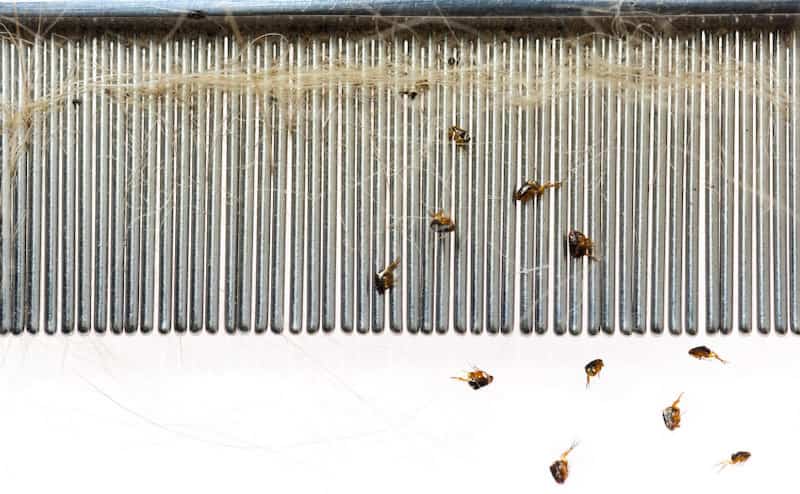
To do that, you’ll also need to pour soap and water into a bucket and keep it on next to you while you’re using the comb. After you run the comb through your cat’s fur, swirl it in the soapy water and then comb your cat again.
Make sure you comb every part of the fur, and then go over each part at least once more. Every time, dipping the comb into the to clean off everything that is trapped in the comb’s teeth. Any fleas or eggs on your cat should wind up floating in the bucket instead of dwelling in its fur.
Repeat this until you can comb your cat without finding more fleas or eggs on the comb.
To be on the safe side, only fill the bucket about halfway to prevent fleas from jumping out.
Give Your Cat a Bath with Flea Shampoo
Giving your cat a good bath will manage to get rid of some fleas and flea eggs on its own, but the flea shampoo has active ingredients that will kill fleas that don’t get washed away in the bathwater.
Flea shampoo also leaves some flea-killing chemicals on your cat’s fur so that it keeps working even after the bath is over.
A flea shampoo, however, is not a long-term solution. The chemicals will only stay on your cat’s fur for about a day, so it won’t prevent fleas in your household from infesting your cat again. (We’ll go over how to prevent these re-infestations in the next section.)
Use a Flea Spray
A flea spray for cats is essentially an insecticide that is formulated that has been formulated to be strong enough to kill fleas while not containing ingredients in concentrations that will be harmful to your cat.
Applying a flea spray to your cat is almost like giving it a flea bath without the water. You spray your cat’s fur with it and then use your fingers to massage the spray into its fur, making sure not to get any in the cat’s eyes or mouth.
The flea spray should kill fleas on contact, and unlike flea shampoos, they should last for more than one day. Some manufacturers claim that their sprays will kill fleas and flea eggs on your cat for up to 30 days. Don’t rely entirely on those claims – keep checking your cat every few days to make sure the fleas haven’t returned.
How to Keep Your Cat from Getting Fleas Again
Killing the fleas on your cat is only the first step to solving your problem. If your cat has fleas, there’s a good chance there are fleas somewhere in your home, whether it’s in your cat’s bedding, living in your carpet, or just about anywhere else.
To make sure the fleas stay off your cat and out of your home, you’ll need to take a few preventative measures. Here are the most common and effective ones.
Give Your Cat a Flea Collar
Flea collars are plastic collars that are made of plastic that is molded by combining plastic resins with flea-killing insecticides. The pesticides slowly seep out of the plastic over time, giving your cat long-term protection. Depending on the collar, it can provide your cat with flea protection for anywhere from 30 days to 12 months.
If you have an indoor cat that isn’t used to wearing a collar, it might not take kindly to having a flea collar placed on it. Give it a couple of days to adjust, but if the collar still bothers your cat tremendously, you can focus on other solutions instead.
It’s also important to understand the risks associated with flea collars before using one. Some cats have an adverse reaction to the plastic and chemicals in the flea collar. Keep checking your cat’s neck regularly. If you notice skin damage or loss of fur, discontinue the use of the flea collar.
The biggest concern, however, is strangulation. Because the collar is made of solid plastic with no elasticity, cats won’t be able to pull their heads out of the flea collar if it gets caught on something. If that something is a tree branch or a cabinet handle that leaves the cat hanging by its neck, it could be fatal.
Despite these risks, some cat owners still opt for the collar since it is a very simple and affordable way to protect against fleas.
Topical Flea Treatment
Instead of flea collars, most vets now administer a topical flea treatment for cats.
These treatments are oily, medicated products that are applied usually at the base of the cat’s neck (because that’s one of the few spots your cat can’t lick). The product stays in the cat’s fur and its flea-killing insecticide is slowly released over time.
Like flea collars, topical treatments are good long-term solutions for preventing fleas. However, they don’t last as long as a flea collar does. To remain effective, you usually need to reapply the topical treatment every month (brands differ in this respect, so be sure to check the packaging).
Check Your Cat Regularly
After killing the fleas on your cat and applying a collar or preventative flea treatment, continue checking your cat regularly for fleas. Like we discussed in a previous section, run a flea comb through your cat’s fur and check the comb to see if it trapped any fleas or flea eggs.
Check for fleas every few days to be sure that you catch any new flea problem early.
If fleas reappear, you will need to take steps to get rid of them again (combing, bathing with a flea shampoo, or using a flea spray) and then reconsider your prevention methods. If you’re using a collar, try a topical treatment. If the topical treatment isn’t effective, ask your vet about trying a brand with different active ingredients.
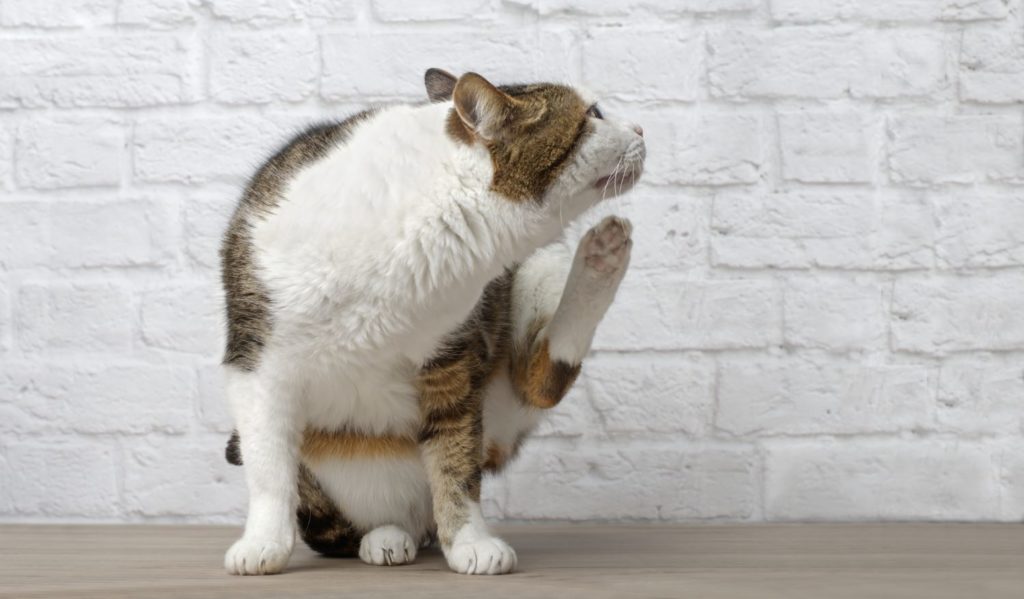
Get Rid of the Fleas in Your Home
No matter how strong your preventative treatments are, if there are still fleas living in your home, they will find their way back to your cat. You will need to get rid of the fleas in your home if you’re going to get your cat back to their flea-free life.
Not every solution is effective, however.
For example, many people try creating a simple flea trap to capture and kill fleas. This is usually done by filling a bowl with soapy water, placing it on the floor, and shining a lamp on it.
Traps like these do work – the fleas will be attracted to the light, hop into the bowl, and die – but they’re just not enough. You’ll kill some fleas, but you won’t eliminate them at the source or get rid of their eggs.
If you really want to get rid of the fleas in your home, take the following steps instead.
Clear the Carpets
When fleas aren’t living on your cat, they’re most likely hanging out in your carpet, so this is where you’ll want to focus most of your efforts.
Before you start, make sure you tidy up and take as much stuff off your carpet as you can. Anything that’s lying around, like clothes or toys, should be put away or moved to a different spot.
If you can, remove the furniture that rests on the carpet. If you can’t, or it’s too difficult, you will have to move the furniture out of the way when you’re vacuuming your carpet to make sure you’re getting everywhere the fleas might be hiding.
Vacuum
Run the vacuum cleaner throughout the house. Again, you will be focusing on carpets and rugs, but you should also run it over hardwood floors (fleas can hide in the cracks) and use the hand attachment or a hand vacuum on any upholstered furniture.
Once you’re done, empty the contents of the vacuum cleaner into a plastic bag, seal the bag, and leave it in an outdoor trash can. That way, if a flea makes its way out of the bag, it won’t be able to infest your cat.
Steam the Carpets
This is optional, but if you want to be extra safe, steam cleaning the carpet will kill the fleas living in it.
Note, however, that it won’t kill flea eggs, so you will still need to deal with the problem.
Foggers and Sprays
A fogger is an insecticide in an aerosol can that will slowly release on its own when you press the nozzle. Set it on the floor of the room you want to treat, press the nozzle, and leave while it slowly sprays out the chemicals into the air.
The chemicals released by the fogger then slowly descend on every surface in the room and kill fleas on contact.
Usually, a fogger requires about two hours to do its work.
Another option is to use a spray that you can aim and direct yourself. This is better for more localized treatments, like spraying down a pet’s favorite sleeping area or their bedding.
Carpet Powder
When you’re done treating a room for fleas, you can make sure that the problem is dealt with by applying powder treatments to your carpets, leaving it for a while, and then vacuuming it up.
You can also use powder treatments to kill fleas in the places that are harder to reach, like the grooves and spaces between or under cushions on your furniture, as well the corners of the rooms and where the edges where the floor meets the walls.
Yard Treatments
If you have an outdoor cat, there’s a possibility that they are picking fleas in your yard rather than inside your home.
Luckily, there are steps you can take to get rid of the fleas in your yard.
First, you need to make your yard less habitable for fleas. Rake your yard regularly to get rid of leaves and other types of cover. You can also keep a sprinkler going to wash away flea droppings, which is a flea larva’s source of nourishment.
Then, you can apply an insecticide spray designed to take care of fleas outdoors. These are usually spray bottles with an attachment for your garden hose. Attach your hose to it, turn on the tap, and spray your yard with the watered-down insecticide.
Don’t forget to spray on and under patios and porches, not just your lawn.
If it rains soon after you’ve sprayed your yard, you may need to treat it again.
Repeat
I mentioned above that you should keep checking your cat for fleas after you’ve gotten rid of them. The same sort of thing applies to getting rid of fleas from your home. It’s not easy to kill off an entire flea infestation. The best thing you can do is keep vacuuming regularly, and maybe set out a flea trap once in a while to see if they’re still a problem in a particular room.
There’s no exact timeframe here. You’ll just have to keep doing it until you’re confident your house is pest-free.
Summary
Getting rid of a flea problem requires a two-pronged approach. You’ll need to get rid of the fleas on your cat, while also working to get rid of the ones in your home.
Fleas are stubborn. It takes time to get rid of an infestation. Often, you’ll need to use a solution more than once – whether it’s a flea shampoo or simply vacuuming your carpets. But unless you have a severe infestation, you should be able to deal with the problem on your own, without having to resort to an exterminator.

